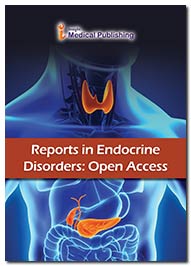A Brief Review on Myxedema Coma
Abstract
Myxedema is a term used synonymously with severe hypothyroidism. Still, the term is also used to describe a dermatological change that can do in hyperthyroidism and (rare) paradoxical cases of hypothyroidism. In this ultimate sense, myxedema refers to deposit of mucopolysaccharides in the dermis, which results in swelling of the affected area. One incarnation of myxedema being in the lower branch is pretibial myxedema, a hallmark of Graves complaint, an autoimmune form of hyperthyroidism. Myxedema can also do in Hashimoto thyroiditis and other long- standing forms of hypothyroidism
Myxedema is a term used synonymously with severe hypothyroidism. Still, the term is also used to describe a dermatological change that can do in hyperthyroidism and (rare) paradoxical cases of hypothyroidism. In this ultimate sense, myxedema refers to deposit of mucopolysaccharides in the dermis, which results in swelling of the affected area. One incarnation of myxedema being in the lower branch is pretibial myxedema, a hallmark of Graves complaint, an autoimmune form of hyperthyroidism. Myxedema can also do in Hashimoto thyroiditis and other long- standing forms of hypothyroidism.
The word myxedema originates from μÏξα, taken from ancient Greek to convey'mucus'or' muddy substance', and á½οίδημα for" swelling". It can also be allowed as nonpitting edema, in discrepancy to bending edema
Hypothyroidism, including Hashimoto's Thyroiditis Primary treatment is urged by the administration of acceptable boluses of either the thyroid hormone L-thyroxine given intravenously or by giving liothyronine via a nasogastric tube. It's essential to identify and treat the condition pouring the coma. Myxedema coma is rare but frequently fatal. It occurs most frequently in senior women and may be incorrect for one of the habitual enervating conditions common to this age group. Though the exact cause of myxedema is still unclear, a wealth of exploration has demonstrated the significance of iodine. In an important study the experimenters showed that in the myxedematous type of cretinism treatment with iodine normalizes thyroid function handed that the treatment is begun beforehand in the postnatalperiod. However, the prognostic remains dismal.
The increased deposit of glycosaminoglycan isn't completely understood, still, two mechanisms predominate. Fibroblast stimulation. It's allowed that fibroblast stimulation by the thyroid stimulating hormone (TSH) receptor increases the deposit of glycosaminoglycan, which results in a bibulous edema and fluid retention. It's allowed that numerous cells responsible for forming connective towel reply to increases in TSH situations. Lymphocyte stimulation. In Graves'thyroid complaint, lymphocytes reply against the TSH receptor by erroneously producing thyroidstimulating immunoglobulin (IgG; type II acuity). Lymphocytes reply not only against thyroid receptors, but also any towel with cells expressing the receptor. This can lead to towel damage and scar towel conformation, explaining the deposit of glycosaminoglycans.
Myxedema describes a specific form of cutaneous and dermal edema secondary to increased deposit of connective towel factors. The connective fibres are separated by an increased quantum of protein and mucopolysaccharides. These can include glycosaminoglycans, similar as hyaluronic acid, chondroitin sulfate and other mucopolysaccharides. This proteinmucopolysaccharide complex binds water, producingnon-pitting boggy edema, in particular around eyes, hands, bases and in the supraclavicular fossae. Myxoedema is responsible for the thickening of the lingo and the laryngeal and pharyngeal mucous membranes, which results in thick vocalized speech and hoarseness, both of which are seen generally in hypothyroidism
Myxedema is known to do in colorful forms of hyperthyroidism, including Graves complaint. One of the emblems of Grave's complaint is pretibial myxedema, myxedema of the lower branch. Myxedema is more common in women than in men. Myxedema can do in Hyperthyroidism, associated with pretibial myxedema and exophthalmos. Pretibial myxedema can do in 1 – 4 of cases with Graves' complaint, a cause of hyperthyroidism.
Open Access Journals
- Aquaculture & Veterinary Science
- Chemistry & Chemical Sciences
- Clinical Sciences
- Engineering
- General Science
- Genetics & Molecular Biology
- Health Care & Nursing
- Immunology & Microbiology
- Materials Science
- Mathematics & Physics
- Medical Sciences
- Neurology & Psychiatry
- Oncology & Cancer Science
- Pharmaceutical Sciences
